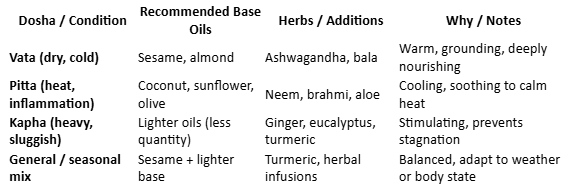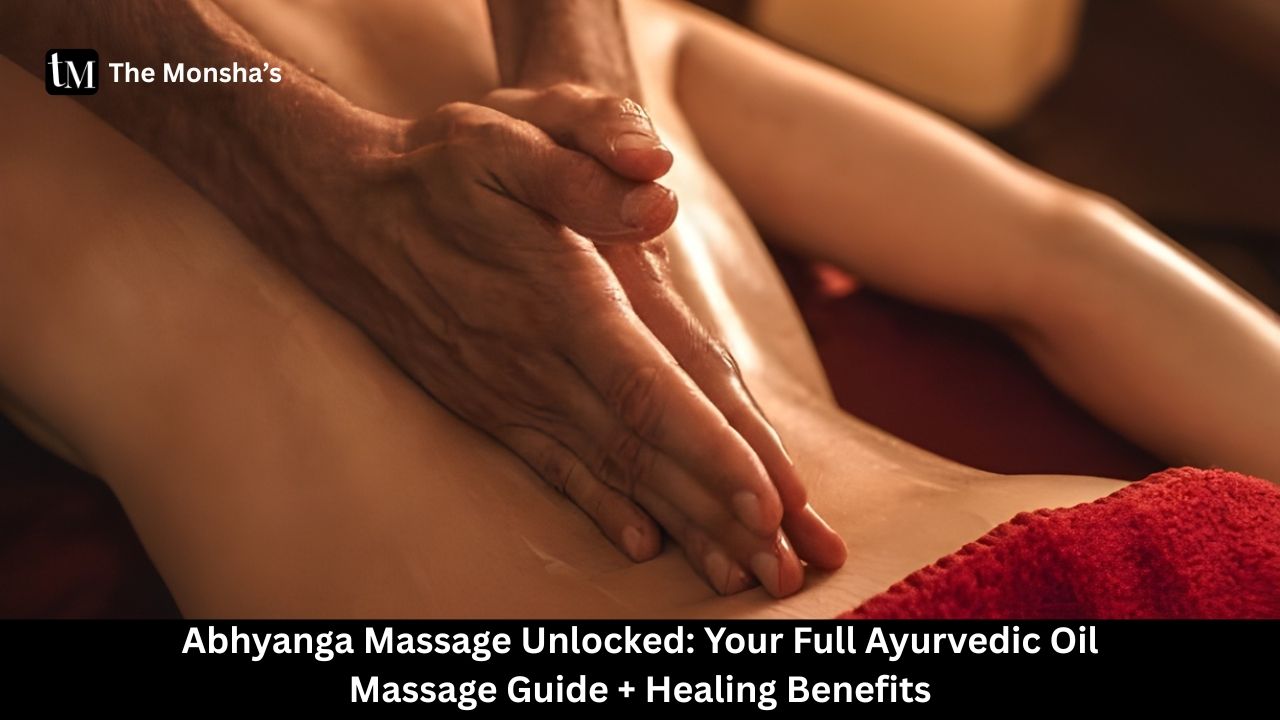TL;DR
Abhyanga is the Ayurvedic ritual of massaging warm, dosha-appropriate oil all over your body. It’s more than self-pampering — it supports circulation, calms your nervous system, nourishes skin, and balances doshas. But technique, consistency, and the right oils matter. This guide gives you everything you need to do it well and safely.
1. Let’s Roll
Some days, life feels like you’re dragging your body through a storm — tension in your back, dry skin, racing thoughts. That’s when I lean on abhyanga — the ancient oil massage ritual that feels like your body getting a warm hug from the inside out.
In this post, we’ll dive into what abhyanga really is, why Ayurveda swears by it, how to do it (self / assisted), benefits, cautions, and some desi flavor (kyunki apni skin bhi deserve karti hai pyar). Ready? Let’s oil up 🛢️
2. What Is Abhyanga? Origins & Philosophy
2.1 Definition & Sanskrit Roots
- Abhyanga means “unto the body” (abhi + anga) — applying oil plus massage in choreographed strokes.
- It is part of Dinacharya (daily routine) in classical Ayurveda texts like the Brihattrayi.
- Traditionally, sesame oil is a base; herbs are often infused depending on dosha or condition.
2.2 Role in Ayurveda
- It’s considered Bahiparimarjana Chikitsa (external oleation therapy) — to soften tissues, nourish dhatus (body tissues), mobilize ama (toxins) and bring balance.
- Prepares the body for deeper therapies (Panchakarma) by loosening doshas & enhancing absorption.
3. How Abhyanga Works: Ayurvedic + Modern Lens
3.1 The Ayurvedic Logic
- Warm oil + massage opens srotas (microchannels) and pushes ama outward.
- Massage strokes follow dosha flow, stimulate marma points (energetic junctions) to balance prana.
- It’s nourishing (snigdha), builds ojas (vital energy), calms vata, soothes nerves.
3.2 What Science Finds
- In a pilot study, a single session of abhyanga lowered subjective stress and heart rate; blood pressure dropped in prehypertensive participants.
- A more rigorous trial over 15 days of regular self-massage showed reduced stress, improved sleep, and better quality of life vs control.
- Massage + oil on skin enhances skin circulation, may improve flexibility, and supports lymphatic drainage (as seen in massage research).
- Reviews affirm that abhyanga improves circulation, nervous system tone, detox pathways, and general well-being.
In short: traditional wisdom + modern evidence align in many ways — but do it right.
4. Healing & Wellness Benefits of Abhyanga
Here’s where the magic shows. Let’s split benefits by area:
4.1 Physical & Tissue Benefits
- Better blood flow & microcirculation
- Enhanced joint mobility / flexibility, less stiffness
- Nourishment of skin (softness, glow, suppleness)
- Supports detox via lymph & aiding elimination
- Loosening muscle tension, relieving aches
4.2 Nervous System & Stress Relief
- Calms the nervous system, reduces stress & anxiety
- Helps lower heart rate, may reduce BP for some
- Improves sleep quality & mental calm
4.3 Systemic / Holistic Benefits
- Balances doshas (especially vata)
- Strengthens immune / systemic resilience
- Sustains vitality, slows signs of aging
- Builds ojas (inner glow / vitality)
- Supports mind-body harmony
People often say post-abhyanga: “Main zyada light feel kar rahi hoon” — body feels fluid, mind calmer.
5. Oil Choices by Dosha / Purpose
Use the right oil and you’ll feel the difference. Here's a handy table:

Tip: Warm your oil (in a bowl over warm water) to body-temperature — not scorching.
6. How to Perform Abhyanga (Self or Assisted)
Follow this stepwise flow for maximum benefit:
6.1 Prep & Environment
- Room should be warm and draft-free
- Use a towel over surfaces; wear minimal clothing
- Warm the oil, have everything handy
6.2 Stroke Sequence & Technique
- Head & scalp (Shiroabhyanga): circular, gentle strokes
- Face / neck: clockwise, gentle
- Limbs: long strokes toward heart (hands, arms, legs)
- Torso: circular motions over abdomen, chest (follow digestion direction)
- Joints: circular + pumping strokes
- Feet & palms: special attention, massage toes, soles
- Back (if assisted or by professional)
Use firm but gentle pressure, consistent rhythm. Don’t rush.
6.3 Duration & Timing
- For full body: 30–45 minutes (or 60+ if you have time).
- Self-abhyanga can be 15–30 minutes for maintenance.
- After massage: let oil absorb 10–15 minutes (or more) before bathing.
6.4 Post-Abhyanga Routine
- Use a gentle warm bath / shower (no harsh soaps)
- Pat dry; leave slight dampness
- Reapply light oil / moisturizer to retain nourishment
You may pair with Swedana (herbal steam) or warm compress to enhance effect.
7. Best Practices & Mistakes to Avoid
- ✅ Be consistent (daily or regular) rather than occasional binges
- ✅ Use warm — not hot — oil
- ✅ Pressure: firm but loving (not rough)
- ❌ Avoid right after heavy meal, acute inflammation, open wounds
- ❌ Don’t skip patch test (especially for herb-infused oils)
- ❌ Don’t bathe immediately with cold water
- ❌ Avoid doing during fever, active Kapha flare, extreme heat
If you feel burning, stinging, or rash — stop and rinse, then wait until skin calms.
8. Real Stories / Indian Touch
One friend in Delhi told me: “Main jab raat 10 baje oil nahin lagati, toh subah mere joints bolte hain ‘wake up yaar’.” She swears abhyanga is her joint lubrication.
In many Indian households, elders massaged children’s feet with sesame oil nightly. That’s abhyanga in pocket-version. Even local wellness therapists in Kerala offer synchronized two-therapist abhyanga (like twin hands flowing in harmony).
In Ayurvedic clinics, they often massage head, ears, feet first — marma points — then move outward, staying in rhythm.
9. Abhyanga vs Other Massage / Oil Rituals

Abhyanga is more ritualistic and integrative, not just muscle rub.
10. Frequency & Integration Into Routine
- Ideal: daily, especially for vata types or in cold/dry climates.
- Alternative: 3–4x/week for others
- Best times: Early morning (before bath) or evening before sleep
- Combine with other Ayurvedic practices: Nasya, Shirodhara, Panchakarma
Start small — even 15 minutes is better than none.
11. Final Takeaway
Abhyanga isn’t just a massage, it’s a ritual of love for your body. When done regularly with intention, proper oils, and technique, it soothes your skin, nerves, and spirit. Pick your oils, go slow, and let the ritual carry you into balance.
Aur haan — agar ek din tel na lagaya, duniya khali nahi ho jaayegi. But you’ll miss the warmth.
FAQs
Q. Can someone with oily / acne-prone skin do abhyanga?
Yes, but choose lighter oils (almond, coconut), less amount, and focus on shorter duration.
Q. How soon after abhyanga can I bathe?
Wait 10–15 minutes (or more) so skin absorbs oil; then take a warm (not hot) shower.
Q. Is abhyanga good for weight loss?
Not a direct fat-burn method. But improving circulation + detox + metabolism helps overall balance.
Q. Can pregnant women / elderly / kids do it?
Yes, with gentle pressure and suitable oils. Avoid deep pressure, especially on abdomen in pregnancy. Always check with a healthcare provider.
Q. What if I feel too oily / sticky afterwards?
Pat off excess oil with a towel, don’t wash entirely. Use lightweight body oil or moisturizer over mild residual oil.


